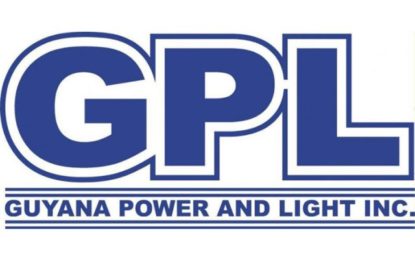Despite performing below standard for yet another year, the Guyana Power and Light Inc (GPL) has escaped penalty since according to the Public Utilities Commission (PUC) the company has made “stellar efforts” during a challenging period.
“The Commission took into account the impact of… COVID19 and the resources of GPL on the company’s ability to achieve it target… [and] determined that the failure to achieve targets did not warrant the imposition of a monetary penalty,” the Commission announced in its first order of 2021.
Since 2010, the PUC has used the utility company’s Operating Standard and Performance Targets (OSPT) as benchmarks for the company in its improvement of its quality service as offered to customers. An annual review conducted by March 30 of the following year is used as a means to judge compliance.
The targets are in the areas of customer interruptions, voltage regulation, meter reading, issuing of bills, accounts payable, accounts receivable, system losses, and average availability.
If the PUC finds that the company has failed to meet its OSPT, it can impose a monetary penalty on the company in an amount not exceeding 25% of the total value of the dividend payable to the company’s shareholders in the calendar year. The last penalty issued to GPL was in 2017 when the PUC imposed a fine of 5% of the total value of dividends.
In 2020, GPL failed to reach any of the eight targets. In the area of customer interruptions the company reported that System Average Interruption Frequency Index (SAIFI) and the System Average Interruption Duration Index (SAIDI) were not met.
There were 99 interruptions which lasted for an average of 81 hours, significantly more than the 65 interruptions for an average period of 75 hours which was the target.
Company representatives claimed that the frequency of interruptions were due to feeder trips and three shutdowns of the Demerara Berbice Inter-connected System (DBIS). The shutdowns “severely impacted the Company’s ability to provide redundancy during maintenance of the transmission system,” the company claimed.
GPL has indicated its intention to construct four feeders which will serve to bolster the redundancy of the network and install several auto reclosers within the transmission network.
In 2020, a total of 90 reclosers were installed, 10 of which were commissioned in an attempt to reduce outage time.
Auto reclosers are devices which are installed to detect momentary faults in a section of the network which will serve to prevent total shutdown. They are also employed during routine maintenance in order to isolate a specific area which may require rehabilitation.
Other targets which were not achieved include meter reading. While the company was required to read 97% of maximum demand consumers and 90% of non-maximum demand customers, GPL reported that for non-maximum demand consumers, only 88% of the meters were read; and for maximum demand consumers, 90% of the meters were read.
The COVID-19 pandemic was reportedly responsibly for this deficit as the exercise stalled for three months during the year.
When it came to collecting sums owned, GPL fell well short as the standard commits the company to a 30-day cash collection cycle, yet GPL reported an average of 109 days for 2020.
During the hearing it was explained that late payment by key government entities including ministries, National Democratic Councils, and the Guyana Water Incorporated, impeded the achievement of this standard.
“In the last quarter of 2020 and for the month of January 2021, the Government of Guyana had made substantial payment to the company for outstanding electricity charges as incurred by these entities… reducing the accounts receivable days to 42,” the Order notes.
GWI continues to be the largest single debtor. It was explained that if that company had satisfied its debt then the standard would have been surpassed at 29 days.
There were however two targets met – the issuing of bills and the settling of debts. GPL was able to issue maximum demand bills within five days of a meter reading and non-maximum demand bills within eight days of a meter reading while payments to creditors were made within 20 days.


